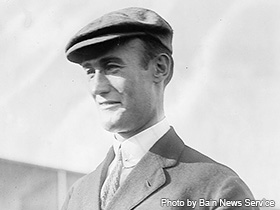You are here

1/12/1879 - 4/3/1912
Descendant of Commodore Perry, Calbraith Perry Rodgers was the first man to fly solo across the United States.
Calbraith "Cal" Rodgers was born January 12, 1879, in Pittsburgh. A descendant of Cmdr. Oliver Hazard Perry, Rodgers grew up in Pittsburgh, Pennsylvania, and attended preparatory school in Mercersburg. He is best known as the first human to fly across the North American continent, starting on Long Island and ending in California. Rodgers died April 3, 1912, in a plane crash accident.
Calbraith Perry Rodgers was born January 12, 1879, to Calbraith Perry Rodgers and Maria Wightman Rodgers. He was born into an environment of mourning, as his father, a captain in the United States Army, passed away five months prior to his birth. He was killed by a bolt of lightning en route to see his family.
Rodgers' early years were marked by his pleasant disposition and interest in all things mechanical. At age six, the boy who would become the first man to travel across North America by air was struck with an intense bout of scarlet fever, leaving him almost completely deaf. This did not help Rodgers' lack of interest in academics. Always more interested in physical activities, he directly contrasted his performance inside the classroom with stellar functioning outside of it.
In fact, Rodgers' daring temperament could be contributed to the long line of prolific adventurers before him that also bore the names "Perry" and "Rodgers." Oliver Hazard Perry, Rodgers' maternal great-grandfather, won a crucial victory over the British Naval fleet on Lake Erie in the War of 1812 when he refused to abandon his ship until it was completely spent, only to move on to another vessel and resume fighting. Mathew Calbraith Perry, Rodgers' great-great uncle, was also adventurous in his own, more diplomatic fashion. Many contribute the trade between Japan and America strictly to Mathew Calbraith's tenacious and unwavering persistence. Moreover, Commodore John Rodgers, Rodgers' paternal grandfather, was also described as being fearless, decisive, and willing to assume all responsibility. These traits led him to quickly climb the Navy hierarchy and become commander of the Navy vessel Constellation.
Despite the adventurous nature of the Perry-Rodgers family tree, the family displayed a deeply rooted religious background. Rodgers was raised in a formal Presbyterian household, which eventually led to his stay at an upstanding preparatory school, Mercersburg Academy in Cumberland Valley. Involved in seemingly everything but the classroom, Rodgers enjoyed participating in football and a number of other clubs. Rodgers benefited from his time at Mercersburg, but upon graduating embarked on a search to fuel his thrill-seeking personality.
Upon moving to New York City, Rodgers found such an outlet: boating. He joined the New York Yacht club, and although he did not personally own a vessel, he jumped at every opportunity to crew anyone's boat he could. It was through his love of the sea that he found the love of his life, Mabel Avis Graves. Mabel describes their first encounter as one from a storybook or a movie. She is said to have slipped while boarding a boat that Rodgers was crewing, and he jumped in and pulled her aboard, thus "saving her" and winning her heart. The first few years of their marriage are slightly unknown, but likely occupied by visits to Mabel's family homes in Wisconsin and Vermont.
Rodgers was said to be constantly roaring about on his motorcycle or in his automobile, always pushing the speed envelope. In 1903, his courageous spirit found yet another attraction. In December, the Wright brothers embarked on their groundbreaking 852-foot flight in Kitty Hawk, North Carolina. John Rodgers, Calbraith's cousin, was selected by the Navy to learn to fly such a machine. John wrote to Rodgers, describing the experience; all Rodgers needed to hear was, "For speed, you can't beat flying!" He immediately made the trip to Dayton, Ohio, began participating in the elementary aeronautics exploration of the day, and was instantly hooked. He then enrolled in the Wright's flying school, and by his fourth lesson, was handling a plane all by himself; in 1911, Rodgers received his pilot's license. At the Chicago International Air Meet, he received his first taste of notoriety for his skills in aviation, winning the most financially rewarding prize — the endurance competition — staying in flight for three hours, twenty-three minutes, and ten seconds.
Amused by his success, Rodgers began to consider an aeronautical challenge proposed by newspaper giant William Randolph Hearst. Hearst offered a $50,000 prize to the first person to completely fly across the United States in thirty days or less. However, the cost of flying across the continent proved too much for Roger's personal pockets; he needed a corporate sponsor. J. Odgen Armour was, at the time, a meatpacking giant, and Armour and Co. was on the verge of unveiling their Vin Fiz, a grape flavored carbonated beverage. It was established that in return for financial support for the duration of the journey, Rodgers's biplane was to serve as a flying billboard for the new product. Thus, his Wright Brothers-crafted plane was dubbed "The Vin Fiz."
The predicament facing Rodgers was clear. The flight would be a test of both mechanical durability and of human perseverance. In Cal Rodgers and the Vin Fiz: The First Transcontinental Flight, Eileen F. Lebow quotes Wilbur Wright as saying, "The man who makes it will be exceptional, physically and intellectually. He will need every atom of courage in his make-up." Supporting Rodgers were his wife, his mother, his longtime friend Charles "Wiggie" Wiggin, expert mechanic Charles Taylor, and a number of other mechanics. These individuals followed Rodgers' progress in a small train assembly consisting of a hangar car containing a spare plane, a repair car featuring a workshop and tools, and a passenger car for those involved.
Rodgers began his arduous journey from Sheepshead Bay, Long Island on September 17, 1911. His original flight plan indicated a trip from New York to New Jersey to meet up with the train that was to follow his progress across the country, then to Chicago and after, directly across the Midwest to California. However, Rodgers' original plan of 250 miles per day was under constant assault from weather and technical and mechanical obstacles. Upon reaching Chicago, Rodgers and his associates realized that the 30-day goal proposed by William Randolph Hearst would not be possible. Their decision, more commercially driven than anything, was to reroute Rodgers's flight south to Texas and then west to Pasadena, California.
Characteristically fearless, and against the wishes of his corporate sponsor, Rodgers was known to perform dangerous stunts for any crowds that assembled to marvel at him and his revolutionary craft. Braving electrical storms in Oklahoma and Kansas, and even shrapnel wounds following an engine explosion over Imperial Junction, California, Rodgers finally arrived in Pasadena. Greeted by large crowds and mass excitement, Rodgers became an instant American hero. Ultimately, he crashed nose-first 15 separate times between New York and California, and the trip required 68 separate landings and take-offs.
However, he wasn't satisfied. Engrained in his mind was the image of him dipping his wheels into the Pacific Ocean, and he would not stop until he acted upon that picture. The short trip from Pasadena to the Pacific Coast was a tumultuous one, and Rodgers crashed hard, breaking both legs, cracking several ribs, and fracturing his collarbone. As soon as doctors cleared him for flight, though, Rodgers was at it again, completing the trip the way he had envisioned it. He taxied into the surf and sand on the sunny California beach on December 10, 1911. The total trip took 49 days, 25 of which were spent on the ground due to climate or mechanical complications. However, Rodgers' in-flight time was a concise three days, 10 hours and four minutes. The Wright EX plane that carried Rodgers from one side of the country to the other is on display in the Smithsonian Air and Space Museum in Washington D.C.
Rodgers's love for flying didn't end when the wheels of his Wright EX touched the Pacific. He continued to fly, providing passenger flights and exhibitions in California. Tragically, however, only five months after his celebrated arrival in California, Rodgers's plane crashed during an exhibition flight and he was killed. According to witnesses, he flew high above a flock of seagulls and upon striking one, began a steep dive toward shallow waters. Rodgers was said to have struggled with the controls, give a frightened glance backward, and then strike the water and sand with terrifying impact. His back, neck, and jaw broken, the daring aviator was dead in seconds.
Calbraith Perry Rodgers' impact extends past the achievement of being the first man to fly across the North American continent. He brought commercial air travel, airmail, and the field of aeronautics as a whole to the forefront of American society, and one can see the effects of the modern versions of such services every day. But what can be learned from Cal Rodgers's life extends past the physical benefits of his efforts. Rodgers was a pioneer in one of the last remaining untapped frontiers of his day. His unwavering persistence and passion for the science, art, and thrill of flying led him to fame, glory, and respect in the eyes of the entire world.
- "Calbraith "Cal" Rodgers." National Aviation Hall of Fame, 2005. Web. 12 Feb. 2010. <>http://nationalaviation.blade6.donet.com/components/content_manager_v02/....
- Lebow, Eileen F. Cal Rodgers and the Vin Fiz, the First Transcontinental Flight. Washington D.C.: Smithsonian Institution Press, 1989.
- "Times Past; Hundreds see famed aviator's fatal crash." Los Angeles Times 3 Apr. 2006, Home Edition.
- Wiggin, Charles S. First Transcontinental Flight. New York: The Bookmailer Inc., 1961.
- Wright EX "Vin Fiz." Smithsonian Air and Space Museum, n.d. Web. 12 Feb. 2010. http://www.nasm.si.edu/collections/artifact.cfm?id=A19340060000.
Photo Credit: Bain News Service. "Cal. Rodgers." between 1910 and 1915. Photography. Licensed under Public Domain. cropped to 4x3. Source: Online Resource. Library of Congress, Prints and Photographs Division, George Grantham Bain Collection.
